#hi..................... lisa lisa isms :)
Explore tagged Tumblr posts
Text

“Nico was staying with Fred [Hughes] during the spring of ’68 in the apartment he’d taken on East 16th Street, just a walk across Union Square from the Factory. Fred doted on eccentrics and Nico was a true specimen: among other things, she thrived only in the gloom – the gloomier she could make the atmosphere around her, the more radiant she became. And the more peculiarities Nico indulged in, the more fascinated Fred became – to find a woman that beautiful and that eccentric was a fantasy come true for him. She liked to lie in the bathtub all night with candles burning around her, composing the songs that would become her second album, The Marble Index, and when Fred came home from Max’s Kansas City really late, she’d still be in the water … Fred was back and forth to Europe a lot. When he arrived back at the apartment one night with all his suitcases, he stumbled into the living room and found that he couldn’t switch the lights on. He saw a candle flickering in another room around the corner and then Nico walked in holding a candelabra. “Oh, Nico! I’m so sorry!” he said, suddenly realizing that Con Edison must have turned off the electricity. “I just remembered I forgot to pay the light bill, and here you’ve been in the dark all this time!” “Noooo, it’s fiiiiine,” she said, positively beaming with joy. She’d had the happiest time of her whole life, drifting around there in the dark for a whole month.”
/ From POP-ism: The Warhol Sixties (1980) /
Andy Warhol recalling the circumstances surrounding Nico’s 1968 magnum opus The Marble Index, released this month (November 1968) 56 years ago. This album of what The Daily Telegraph would call “depraved Germanic lullabies” – which makes ideal post-Halloween listening! - would be the first in the gloomy diva’s bleak trilogy (Desertshore (1970) and The End (1974) followed). I bought my first copy as a teenager from a used record store and was mesmerized by the challenging music and Nico’s inscrutable Mona Lisa expression on the cover. Portrait by Guy Webster, 1968.
#nico#christa päffgen#andy warhol#the marble index#guy webster#lobotomy room#warhol superstar#heroin ravaged chanteuse#marlene dietrich of punk#wraith cheekbones#countercultural marlene dietrich#moon goddess#velvet underground and nico#german diva#german chanteuse#punk diva#punk chanteuse#morbidly beautiful
12 notes
·
View notes
Text
Subjectively ranking the Top 10 most influential artists and the works that changed the art world: An ‘Ism’ Overview - Perspectives Comparing And contrasting art movements
Leonardo da Vinci (1452-1519): Leonardo is considered one of the most brilliant minds in history, and his art spans across various genres. His most famous works include the Mona Lisa and The Last Supper, which revolutionized painting techniques, particularly in the use of light and shadow.
Michelangelo Buonarroti (1475-1564): Michelangelo is best known for his sculptures, including the statue of David and the Sistine Chapel ceiling frescoes. He is associated with the High Renaissance period, and his works remain significant in the art world due to his technical expertise and realism.
Pablo Picasso (1881-1973): Picasso is regarded as one of the most important artists of the 20th century, co-founding the Cubist movement with Georges Braque. His most famous works include Les Demoiselles d'Avignon, Guernica, and The Old Guitarist. Picasso's works paved the way for modern art, particularly in the use of abstraction and unconventional materials.
Vincent van Gogh (1853-1890): Van Gogh is known for his post-Impressionist style, which was characterized by bold colours and emotional expression. His most famous works include Starry Night, Sunflowers, and The Potato Eaters. Van Gogh's works were a precursor to Expressionism, which emphasized the emotional and spiritual content of art.
Rembrandt van Rijn (1606-1669): Rembrandt is considered one of the greatest painters in European history, specializing in portraiture and Biblical scenes. His most famous works include The Night Watch and Self-Portrait with Two Circles. Rembrandt's use of light and shadow, as well as his ability to capture emotions, influenced the Baroque period of art.
Henri Matisse (1869-1954): Matisse was a leader of the Fauvism movement, which emphasized bright, bold colours and simplified forms. His most famous works include The Dance, Red Room, and Harmony in Red. Matisse's use of color and form paved the way for the development of Abstract Expressionism.
Johannes Vermeer (1632-1675): Vermeer was a Dutch painter who specialized in interior scenes, particularly of women. His most famous works include Girl with a Pearl Earring, The Milkmaid, and The Art of Painting. Vermeer's use of light and shadow, as well as his attention to detail, influenced the development of Realism.
Salvador Dali (1904-1989): Dali was a Spanish surrealist painter who specialized in creating bizarre, dreamlike images. His most famous works include The Persistence of Memory, The Hallucinogenic Toreador, and Soft Construction with Boiled Beans. Dali's works challenged traditional notions of art and reality, paving the way for the development of Surrealism.
Wassily Kandinsky (1866-1944): Kandinsky was a Russian artist and art theorist who is credited with creating the first purely abstract works of art. His most famous works include Composition VIII, Composition VII, and Black and Violet. Kandinsky's works paved the way for the development of Abstract Expressionism, which emphasized the spontaneous, subconscious creation of art.
Claude Monet (1840-1926): Monet was a French Impressionist painter who specialized in capturing the effects of light and atmosphere in his works. His most famous works include Water Lilies, Rouen Cathedral series, and Haystacks. Monet's use of light and colour influenced the development of Impressionism, which emphasized the fleeting nature of light and colour in art.
3 notes
·
View notes
Note
House MD for the top 5 things. Choose wisely
oooo thank you so much. finally i can bitch about this
top 5 things i would change in: house md
1. season 6 finale for the love of god. someone has to. im not a huddy hater but i absolutely despise the way they ended up getting together. and it's such a good episode up to that point! delicious whump! emotional torture! this is for sure one of the best premises for an episode this series has ever had. and then they had to tease sth for the next season in the last 5 minutes so they did the most out-of-character idiotic scene to ever exist. terrible. so ideally i would have made huddy get together sometime earlier in 6th season (not much, just maybe one, two episodes earlier) and house's breakdown in the finale to be a problem already for the two of them to overcome. or made huddy happen a few episodes into s7, and have either cuddy come to house in the s6 finale but not sleep with him, or have wilson come there and sleep with house somehow make house pull himself together
2. speaking of how huddy happens in canon, i would also love to change the episode in which cuddy breaks up with house. it's a terrible episode. it's boring. it's the same plot as the episode with cuddy's mum that was only like, what, 5 episodes earlier?? cuddy is behaving extremely out of character, and the breakup comes off very cheap. so. first of all, get rid of the cuddy cancer scare plot (i meannnn it's a nice parallel to wilson later, but it's really not worth it). second of all, have her break up with house in a more rational way, having decided he is too much of a mess, or that her career is too important to her to have to accomodate house at work all the time, or anything else. just have it be a product of rational thinking and not. this shit.
(overall i would have loved for huddy to happen sometime in the earlier seasons, like season 3 i think would be great! then they could have broken up bc of cuddy wanting a child and house not or sth, and they would have many many seasons post-breakup to somehow mend their working relationship and maybe even get to the point of house being a family friend)
3. there are so many -isms and -phobias in this fucking series. so. less of that, pretty please. i'm fine with house being a terrible person in this instance but i would love for the overall narrative to show him the middle finger for it more often. i would especially love to have a transgender or intersex character appear and not be ridiculed bc really. they were pushing it with the gender-related queerphobia.
4. cameronnnnn holy shit could we please get some decent and consistent writing for cameron. she doesn't have to be likeable, just. uaughhh. ok so i would lean more into her forming weird codependent relationships with patients, and her general emotional fuckedupness. i would have added a cameron-centric episode just before the wedding or just after it to show that she's not 100% invested in this relationship. also an episode concentrating around her work in the ER and her coping with how many patients go through her hands and how she doesn't remember most of them. also i would change her name to literally anything that doesn't end in -on like pleaseeee this is a nightmare i can't stand her being named allison cameron. let it be alice.
5. seasons 7 and 8 and the A-plot – B-plot balance. pisses me off when house is spending whole episodes not doing his job. go back to the ducklings. or ignore the case but at least do it on the hospital grounds - speaking of which, ROOF SCENES, WHERE ARE MY ROOF SCENES. there were some really nice roof scenes in the first seasons. i want the roof to feature more in the later seasons. if house must Not Do his job then at least i'd have him doing something silly on the rooftop. hot wheels track. painting the mona lisa naked. whatever.
also #6 bonnie girlie i'm obsessed with you. more bonnie. my favourite worst real estate agent in new jersey. i would have her appear once per each season. she is thirteen's one night stand. she is a clinic patient. she is selling kutner's flat. i would love for there to be more bonnie.
7 notes
·
View notes
Text
“Nico was staying with Fred [Hughes] during the spring of ’68 in the apartment he’d taken on East 16th Street, just a walk across Union Square from the Factory. Fred doted on eccentrics and Nico was a true specimen: among other things, she thrived only in the gloom – the gloomier she could make the atmosphere around her, the more radiant she became. And the more peculiarities Nico indulged in, the more fascinated Fred became – to find a woman that beautiful and that eccentric was a fantasy come true for him. She liked to lie in the bathtub all night with candles burning around her, composing the songs that would become her second album, The Marble Index, and when Fred came home from Max’s Kansas City really late, she’d still be in the water … Fred was back and forth to Europe a lot. When he arrived back at the apartment one night with all his suitcases, he stumbled into the living room and found that he couldn’t switch the lights on. He saw a candle flickering in another room around the corner and then Nico walked in holding a candelabra. “Oh, Nico! I’m so sorry!” he said, suddenly realizing that Con Edison must have turned off the electricity. “I just remembered I forgot to pay the light bill, and here you’ve been in the dark all this time!” “Noooo, it’s fiiiiine,” she said, positively beaming with joy. She’d had the happiest time of her whole life, drifting around there in the dark for a whole month.”
/ From POP-ism: The Warhol Sixties (1980) /
Andy Warhol recalling the circumstances surrounding Nico’s magnum opus The Marble Index, released this month 55 years ago (November 1968. The precise date is seemingly lost in the mists of time). This album of what The Daily Telegraph would call “depraved Germanic lullabies” would be the first in the Nico’s bleak trilogy (Desertshore (1970) and The End (1974) followed). I would have bought my first copy aged around 18 from a used record store and was mesmerized by the challenging music and Nico’s inscrutable Mona Lisa expression on the cover.




Nico, (1968)
#nico#christa paffgen#the marble index#heroin ravaged chanteuse#moon goodess#warhol superstar#wraith cheekbones#punk diva#high priestess of punk#marlene dietrich of punk#christa päffgen#guy webster
91 notes
·
View notes
Text
Devil Summoner: Akechi Goro vs the Phantom Thieves Chapter 12 The Ism's, Journal and Vandal
"Despite being barely more than twenty-three years old, Sayuri has quickly become one of the most recognizable examples of modern Japanese art. A genre-defying blend of traditional brushstrokes with global inspiration, the sad, serene woman in red has captured the imagination of visitors for years. The longing look of the subject invites the viewer to project their own longing onto the canvas, but like the Mona Lisa's smile, the source remains one of the art world's greatest mysteries-"
The museum attendant kept talking as Akechi pulled away from the group of tourists to approach Sayuri more closely. Like the Mona Lisa, it was behind a full half-inch of bullet-proof glass and encased in a steel box that would drop into the floor if the staff suspected a robbery was afoot. Though Madarame made a mint making rare reprints, the original held such fascination that even Goro found himself looking at it a little longer than he would any other painting.
"I mean it's no Last Supper but it's nice."
A soft voice behind him nearly made Goro jump out of his skin. He whipped around, reaching for his weapon until he saw that it was the same black-haired smartass that nearly made a fool out of him at the TV station.
"Sorry," Smartass said, holding his hands up with an infuriating twinkle in his eye. "Didn't mean to scare you."
"Too much caffeine," Goro said, adjusting his jacket and trying to regain composure. "What are you doing here?"
"Is there something to do at an art gallery besides look at art?" Smartass said, lip quirking as Goro suppressed a scowl. "I'm glad I saw you again; I was going to catch you after the recording, but-"
"I had better things to do," Goro said, his veneer of civility hanging on for dear life.
"Clearly," Smartass said. "Just wanted to apologize in case I said anything to make your day even worse…I don't really want to end up on the shit-list of a police officer."
Goro snorted. "My shit-list is a little full at the moment; I'm not going to be able to squeeze everyday annoyances in for a while."
"Of course," Smartass said. "You have some pretty big names on that list these days, don't you?"
Bigger than a skinny slip like you, Goro thought with a tight smile. "I'm sorry, didn't you say you were a university student?"
"I might have," Smartass replied.
"Don't university students usually attend university classes?" Goro said. "Or do your parents like wasting money on your education so you can play hooky and admire the pretty pictures?"
Smartass fished a laminated badge out of his coat pocket, the word PRESS stamped under a photograph and above a name.
Kurusu Akira? Goro thought, eyes travelling between the badge and the student's face. If that's his real name, I'm going to swallow a Slime; what kind of moron does he take me for?
Read More
Start from the Beginning
0 notes
Text
@wmbld, 𝒂𝒓𝒆 𝒚𝒐𝒖 𝒔𝒖𝒓𝒆 𝒕𝒉𝒆 𝒐𝒏𝒍𝒚 𝒚𝒐𝒖 𝒊𝒔 𝒚𝒐𝒖?
𝒕𝒉𝒆𝒓𝒆 𝒊𝒔 𝒂 𝒇𝒓𝒊𝒈𝒉𝒕𝒆𝒏𝒆𝒅, 𝒃𝒆𝒂𝒕𝒊𝒏𝒈 heart in her chest, as she opens the door to the hospital room. the monitor in the corner does nothing to relieve her, when it beeps so slowly. a deep, shuddering breath, &. lisa moves to work. she doesn’t get paid to stand around in horror, after all. even when injuries like this other lisa are so severe.

“ hello, ” she says softly, as her hands methodically move through cords &. spare sheets, as she tries not to look at the still body. the low hum of the lights greet her in turn. “ i hope i don’t wake you up, ma’am. it’ll only be a moment. ”
#╰ ... ❪ 𝒕𝒉𝒆 𝒎𝒊𝒔𝒕𝒂𝒌𝒆 𝒐𝒇 𝒂 𝒔𝒊𝒏𝒈𝒍𝒆 𝒏𝒊𝒈𝒉𝒕. ❫ * ♡ . v. sh. ... ◞#╰ ... ❪ 𝒕𝒉𝒆 𝒎𝒊𝒔𝒕𝒂𝒌𝒆 𝒐𝒇 𝒂 𝒔𝒊𝒏𝒈𝒍𝒆 𝒏𝒊𝒈𝒉𝒕. ❫ * ♡ . in chara. ... ◞#╰ ... ❪ 𝒕𝒉𝒆 𝒎𝒊𝒔𝒕𝒂𝒌𝒆 𝒐𝒇 𝒂 𝒔𝒊𝒏𝒈𝒍𝒆 𝒏𝒊𝒈𝒉𝒕. ❫ * ♡ . wmbld. ... ◞#wmbld#hi..................... lisa lisa isms :)
1 note
·
View note
Note
I don't know about the US but in the UK class ism is still a really big thing and it makes sense that JK would use blood purity as a metaphor/allegory(?) for classism. Especially as that is what she would have experienced growing more of the disadvantages from being from a 'lower class' in Scotland.
Like, I am a big believer in the death of the author but sometimes we do have to take them into account.
And people in the UK like to believe there is ko racism here.
Oh I didn’t know that!! But yeah it would make sense for her to use classism since it would be something she experienced.
And it makes even more sense when you remember that she based Hermione on herself! So it is possible that she was bullied by the rich kids and that influenced Draco’s behaviour.
- Lisa
When Lisa first mentioned class a few posts ago, I had the same thought about economic class, but at risk of speaking for her, I came to assume that she meant other kinds of classes. (Thinking, for example, about the cafeteria seating chart from the movie “Mean Girls.”) I think that puts her argument in a more clear perspective.
That being said, I agree with you, Anon, that classism could make sense, but I disagree that it’s the case for the blood purity allegory. Classism is why P&P is my favorite book of all time. I come from a low SES myself, and so I think about classism regularly. And in this case, I think thinking of muggleborn versus pureblood from an economic class perspective is short-sighted. The Weasleys and The Malfoys show two different extremes of economic class but the same level of blood purity. Granted, the Weasleys are “blood traitors” and maybe it goes to show how disagreeing with the societal structure can reduce your elevation within said society. But alternatively we have Hermione’s parents who are dentists and would have a perfectly respectable income despite being muggles. Harry has a vast fortune from his Potter heritage, but the Dursleys also have a fine middle-class income as muggles. So I think economic class can stand on its own two legs in the book without needing the additional allegory.
-Shirlyn
10 notes
·
View notes
Text
“Nico was staying with Fred [Hughes] during the spring of ’68 in the apartment he’d taken on East 16th Street, just a walk across Union Square from the Factory. Fred doted on eccentrics and Nico was a true specimen: among other things, she thrived only in the gloom – the gloomier she could make the atmosphere around her, the more radiant she became. And the more peculiarities Nico indulged in, the more fascinated Fred became – to find a woman that beautiful and that eccentric was a fantasy come true for him. She liked to lie in the bathtub all night with candles burning around her, composing the songs that would become her second album, The Marble Index, and when Fred came home from Max’s Kansas City really late, she’d still be in the water … Fred was back and forth to Europe a lot. When he arrived back at the apartment one night with all his suitcases, he stumbled into the living room and found that he couldn’t switch the lights on. He saw a candle flickering in another room around the corner and then Nico walked in holding a candelabra. “Oh, Nico! I’m so sorry!” he said, suddenly realizing that Con Edison must have turned off the electricity. “I just remembered I forgot to pay the light bill, and here you’ve been in the dark all this time!” “Noooo, it’s fiiiiine,” she said, positively beaming with joy. She’d had the happiest time of her whole life, drifting around there in the dark for a whole month.”
/ From POP-ism: The Warhol Sixties (1980) /
Andy Warhol recalling the circumstances surrounding Nico’s magnum opus The Marble Index, released this month 55 years ago (November 1968. The precise date is seemingly lost in the mists of time). This album of what The Daily Telegraph would call “depraved Germanic lullabies” would be the first in the Nico’s bleak trilogy (Desertshore (1970) and The End (1974) followed). I would have bought my first copy aged around 18 from a used record store and was mesmerized by the challenging music and Nico’s inscrutable Mona Lisa expression on the cover.





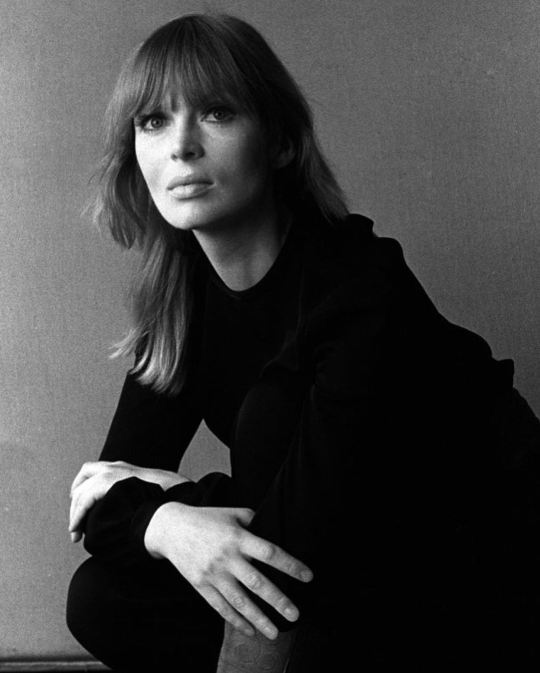
41 notes
·
View notes
Text
overall this season was pretty decent. i have some thots whats new so im gonna share them below the cut if anyone’s interested :)
so!! first off i’ll say that there were a lot of things i did really enjoy from season 4!
the action was super fun as always!! i loved all the crazy enemies and callbacks! the skeleton fight and all those little goblins they kept killing throughout were a nice touch ;) sypha’s use of her powers is INSANE her ice-chainsaw?? her WALL of fire?? electric balls?? come on. and the animation was NICE. i really wanna know who did most of the fight scenes bcuz the style is so different and it just POPS but in a really good way?
my favorite fight has to be ofc when everyone is REUNITED yes im basic. but the THEME song going off and well, im a whore for sotn references and i CAME when i saw the leap stone ref w the winged cape or when alucard turned into a hoard of batss AND THEN HIS WOLF FORM OOOOHH BABY!!! actually episode 9 is just a straight banger.
STRIGAAA. STRIGA. oh mama i was sweating during that fight. mad kudos to her va for them growlsss
carmilla vs isaac was a lot of fun and i loved the visuals but my hype was instantly ruined when i saw her kill herself 😭but thats smth i’ll complain about later.
not all the lines were bangers, some of sypha’s swearing seemed even a bit too much at times, and it was especially jarring to be having a face-to-face death-math with literal Death and hes acting like a naughty little 5 year old thats just learnt to swear. maybe cut back on the fuck-isms? just a bit? BUT when they hit they did GOOD. “the fuck what now?” yes
ISAAC. you weren’t in this season as much but man do u still shine through. i loved his introduction back in the town where he has his night creatures digging graves and rebuilding the city 😭 and then the conversation he shares w his flyman?? obsessed.
Hector chopping his finger off and giving lenore and carmilla a good ol FUCK YOU!! as he helps isaac. we love to see it
Trevor and Sypha’s “I love you!” “I know.” <3
DEATHHHHHHHHHH!!!!!!!
oh! alucard actually having a story & purpose in the plot? :) luv it love to see it. that being said... the Plot.
its... ok? it’s kind of split up into 3/4 parts, as the story progresses, one eventually merges with several of the others kind of? cohesively? while leaving the other to sort itself out.
now, i didnt have too many qualms with it, it was pretty straight forward. dracula is going to be resurrected and we have sypha and trevor looking in on it, while alucard helps the nearby village and hector and isaac go on about bringing on their inevitable showdown. however, the way the story was paced and some of the decisions they made... werent so great.
st. germain for example, brought the ENTIRE momentum from the last few episodes to a halt. you have sypha and trevor fighting through heaps and heaps of monsters only to find themselves back in Targoviste where they meet the mysterious Zamfir!! and Alucard!! he’s been asked to help save this village!! all jam-packed with crazy action and animation that leaves you fired up!! and then episode 5 comes to a screeching halt and we spend nearly the entire thing on st. germain’s backstory and explaining his motives for the rest of the season
like. imma be real with you chief: he didnt need to be here lol. you could have just left varney as the main vamp in charge of bringing back big daddy drac and he could reveal to his.. idk henchmen or something that he’s death. but u gotta fill them ten 20 minute slots somehow!! he just fell so flat and unfortunately, a lot of the side-characters suffer from this this season.
i enjoyed great and zamfir, i love their desgins esp, but they really could have been fleshed out more. zamfir is shown as nothing but a spoiled brat the majority of the time she’s on screen but they wait till she’s about to die to try and turn her character around? huh? greta is given a bit more screentime but this sudden confession of feelings in the last episode felt so... huh?? why couldnt she just be dedicated to her people and show that u can love someone w/out necessarily being their partnr? i thot that was her whole thing; taking care of her people. it’s like. where did this come from. they cant have known each other more than a week at most dog 😭
it sucks they dedicated to much time to scenes that didnt really need to be there where we could have gotten this proper development, like maybe have a scene zamfir and sypha connect over struggles they’ve dealt with in the past and that has her open up about how traumatizing dracula’s attack on her city was. u could have expanded upon her role in the court and WHY she worshipped the monarchy so much instead of making it a throwaway gag about her being “crazy”. but why have that when we could instead spend the first 5 minutes of said episode watching a monotonous back-and-forth b/w varney and that big burly russian vampire who’s name im sure mor than 98% of the audience cant even remember?
just a lot of fat that needed to be trimmed so that the actual MEAT of the story could be slow cooked to perfection. people really arent kidding when they say less is more.
another big problem i had was there... i dont even know what to call it, re-humanization? redemption? of Lenore. like lmk if im wrong but she manipulated hector, yeah? coerced sex to slip on that ring that binds him to her?? orr whatever weird shit warren’s into. but the way they interacted, ESPECIALLY in their first major scene together was sooo uncomfortable to watch lol at first i thought perhaps hector was only playing along because well. hes enslaved to do her and carmilla’s bidding. but no, he actually LIKES her. he spares her when isaac comes around, he says that he wants to keep her as his own. and in the meantime, lenore finds time to complain to a man that’s been beaten and enslaved how upset it makes her that carmilla got angry at her 😭 or says thats she tired of isaac keeping tabs on her and wants to escape this ‘cage’. to aman thats literally been imprisoned since youve known him 😭her death is seen as peaceful, calm, they even try and tug at ur heartstrings by swelling this sad, dramatic music as the sun rises. really? LENORE?
and carmilla’s death happened WAYY too early imo. she was the villain for practically 3 seasons and this is how she goes? isaac couldnt get more than a stab at her? his night creatures couldnt take a nibble? HECTOR couldnt even be given a chance to do somethng like come on
the resolution was... strange? it was cute!! and happy!! but i dunno if they really needed to have lisa and vlad coming back, but, like i said; it was cute! definitely not the ending i was expecting.
i’m glad that they put their focus back on what made the show so much fun and that was the FIGHTS. they definitely helped add some much needed spice to things when scenes started to drag, but im a gal that really luvs a good story and even though reviews were raving that this season helped closed the lid on all the themes theyd been exploring, i just didnt really see that. which isnt necessarily a BAD thing, i knew i wasnt gonna find some deep introspective themes in this hack n slash horror-fantasy, its just what can turn somethng like this from an ok show to a GREAT one.
in the end, im glad they stopped at this one and im curious to see if they really DO go ahead on making spin-offs. bcuz unfortunately, i will always be down for som new castlevania content
#cv4#this is REALLY long#and BRIMMING with spoilers#so read at ur own discretion#otherwise ty for spending ur valuable time to hear what a random sob like me has to say <3
5 notes
·
View notes
Text
Reviewing Recently Read Books... Part II

I’ve been working more so this bunch took me a little over two weeks to get through, but I really enjoyed a lot of them! Again, I’ll be reviewing in the chronological order of how I read them.
Dracula by Bram Stoker 3.5/5 stars
Synopsis: I mean it’s Dracula,, classic horror. Vampire “I vant to suck your blood” guy.
My thoughts: What people say is true, the novel becomes Very funny when you know (through being a person in society) who Dracula is. Pretty engaging, but I was disappointed by the lack of action in the story. Makes sense as a classic though.
The Temple of My Familiar by Alice Walker 4/5 stars
Synopsis: OK so I didn’t realize this is supposed to be read after The Color Purple and the library didn’t have The Color Purple so I read this first. I think it’s some of the same characters but not necessary to have read The Color Purple so I still enjoyed it. Followed a few entwined families through their struggles both with racism/sexism/lots of isms and personal issues.
My thoughts: Pretty wonderful writing. It felt like poetry a lot of the time. Alice Walker does some cool stuff with multiple lives/playing with time that I really enjoyed. I think I probably should have read The Color Purple first, but we all make mistakes.
Three Act Tragedy by Agatha Christie 3/5 stars
Synopsis: Another Hercule Poirot book! Classic whodunnit. You know it had to be on here, I love mysteries too much.
My thoughts: While I love my detective man Poirot I was not a huge fan of most of the minor/supporting characters in this one. I did not fully guess the end though so that’s nice! (Agatha Christie is still the worst, see other posts where I talk about her for more details)
Where the Crawdads Sing by Delia Owens 5/5 stars
Synopsis: The story of a murder investigation unfolds alongside the story of an abused and ostracized young girl’s life in the North Carolina marshlands. This girl happens to be the suspect of the murder investigation.
My thoughts: Everyone I know has been raving about this book for months so I gave it a try. And... beautiful,, heart-wrenching, wonderful. Plus it had mystery elements in it which I love. I really enjoyed this, and not just because I’m from NC.
Homegoing by Yaa Gyasi 5/5 stars
Synopsis: So much happens in this book. We start off with two sisters, separated at birth (I believe), one of which is kidnapped into slavery and one of which remains in Africa. We follow their descendants into current times.
My thoughts: This is probably my favorite book I’ve read this year. The scale that Gyasi tackled here was daunting, but the book flowed so well and was truly engaging the whole way through. What hit me the most was how putting these horrific events in terms of generations contextualizes them. Instead of, “this happened X many years ago,” it was “this happened X many people ago” and that was incredibly powerful to me.
The Martian by Andy Weir 4/5 stars
Synopsis: Astronaut is assumed dead on Mars as his team is making an escape attempt. Surprise: he is not dead. Now he has to find a way to survive on Mars and somehow communicate with earth in order to have any hope of rescue.
My thoughts: This book was Fun. I very much enjoyed reading it; everything felt plausible in a cool way, and the tone was super funny and light. Just fun and cool.
Three Women by Lisa Taddeo 3/5 stars
Synopsis: TW for sexual assault. This is non-fiction. Taddeo interviewed three women at length about their sexual experiences (one of which was groomed by a teacher in high school) and told their stories through the narrative.
My thoughts: Important, but I wasn’t a huge fan of the writing style. The stories themselves were compelling and I’m glad I read it, because I think it showed a lot about how women are judged, both by others and internally. Not my favorite but I certainly don’t regret reading it.
Recursion by Blake Crouch 4/5 stars
Synopsis: Neat sci-fi! Scientists trying to find a cure/treatment for alzheimer’s accidentally find out you can send people back in time through their memories, and their actions will affect the current timeline. Chaos ensues.
My thoughts: I had a lot of fun reading this book! Very cool sci-fi. The concept that all of time is happening all the time (and we are simply limited in our access to it) is one that I think about a Lot and this book really delved into it. Pretty neat!
#books#bookblr#reading#what I'm reading#recently read#dracula#recursion#three women#the martian#homegoing#where the crawdads sing#hercule poirot#the temple of my familiar
2 notes
·
View notes
Text
BNHA Rewatch: Episode 27 “Bizarre! Gran Torino Appears!”
mysterylover123
The Internship arc starts off with a bang! Let’s see that Full Cowl, Deku!
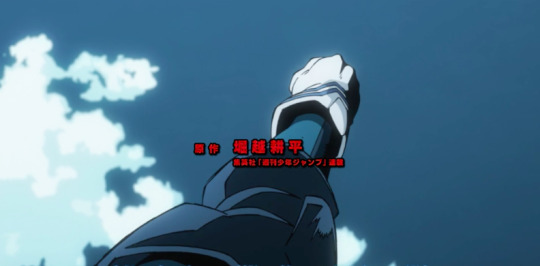
SORA NI UTAEBA! While the song in this intro is kinda meh to me, the visuals are amazing. I love the symbolism for all the events of the ep - tho not gonna lie, this core’s ED is better than the OP. Anyway tho, go punch that wall Deku!
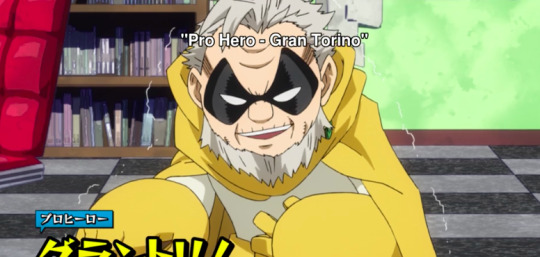
We start with Gran Torino pretending to be crazy. I’ll admit, I’m kinda eh on this bit, though I love Gran. It’s probably because I found it annoying when Yoda did it, so I find it annoying here as well. (It’s really just my inner fangirl talking. Nobody makes Deku unhappy except Kacchan. Who can get away with it.)

But actually, this sets up an interesting difference between Deku and Luke, though admittedly situation isn’t the same because Deku knows Gran is Gran. But Deku’s response to this is to call All Might to tell him Gran’s gone senile. He’s so empathetic Deku why aren’t you real? (no shade at Luke there,e I love him too. Just not as much).

“I don’t have time to mess around.” Deku did not come to play.

New costume! It’s incredible how much better it is than the old one. Like, not even funny how much better. Day-um, Deku.
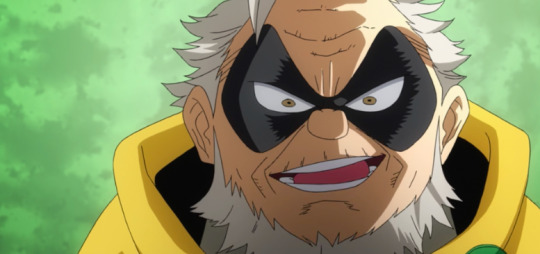
Pfh Gran knows exactly how to piss off Deku: Insult All Might. You clever little scoundrel.
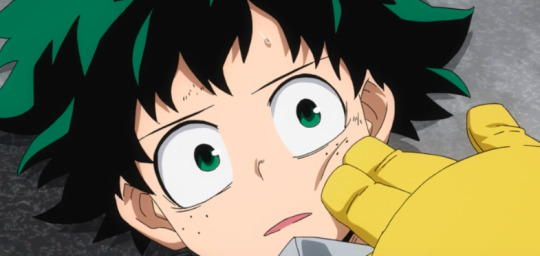
So onto Deku’s character flaws: 1. He’s overly analytical. Deku doesn’t know how to act quickly, partially due to circumstance, but partially that’s just how he is. Hesitant. Over-cautious, over-thinks things. He needs to learn how to take action - and in this arc, he does indeed do so without hesitation, and saves Iida’s life by so-doing. Box 1 checked off.
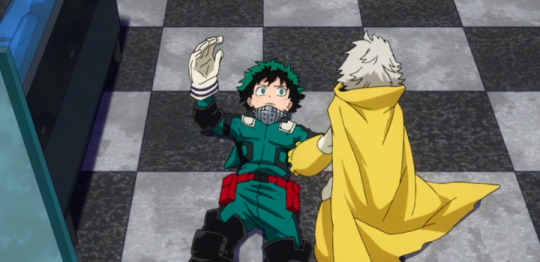
2. Deku admires All Might too much. Like every MC in BNHA, his Imitation is the Sincerest Form of Tragedy (insert me telling you to read that essay again). It’s a problem because he doesn’t believe in himself. So he needs to learn not to imitate All Might and be his own hero. That one doesn’t really sink in until the PLE arc. But check.
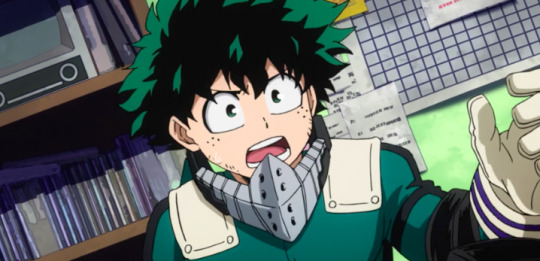
3. Deku is insecure. He has a massive inferiority complex (which fits nicely into his foil’s inf-sup complex, wouldn’t-cha-know) and doesn’t believe in himself. So he needs to learn to be more confident. (Is it wrong that I want this to end with him breaking through Instrumentality to a chorus of his friends saying ‘Congratulations’?)

Gran is my favorite Teacher, as a teacher, in BNHA. I’m a teaching-major, and I kinda aspire to his techniques. What I love the most is helping students figure it out themselves. Just telling someone the answer doesn’t help them. It’s so satisfying seeing a student make that breakthrough thanks to your guidance.

Now we’re cutting away to Iida’s internship to remind you Iida Wants Revenge. This is a little exposition-y, let’s cut somewhere else.
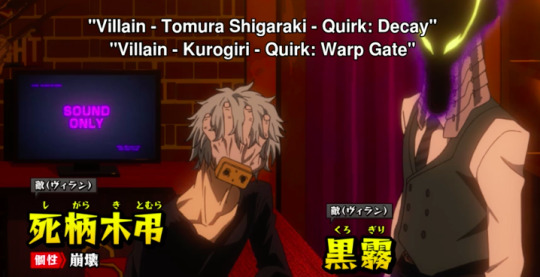
OK good, the villains! Right off the bat, we’ve got some great Parallels with the Heroes, as Tomura decides to basically Intern with a Pro-Villain. He even calls Stain a pro. Tho Tomura really needs to work on his recruitment strategy. “Stain join us. Cause.” “Bakugou. Join us. Cause”.

I want Deku and Tomura to build a grand Hero-Villain rivalry. Tomura basically hates him for no real reason right now, and I want there to be a good reason. Other than “He’s All Might’s successor”. I want them to be the Joker and Batman of BNHA with a real complex hero-villain rivalry, where one reflects the other. They’re getting there but I want more.

“Bloodlust without conviction is meaningless.” Ooh I love me some Stain. He really elevated this series’ philosophical side with his ramblings on heroism and villainy.
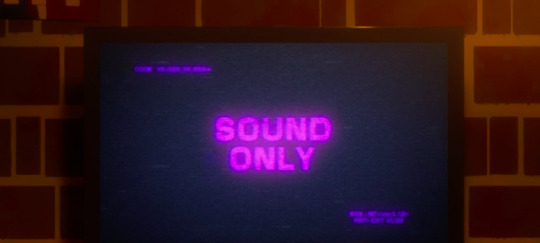
OK am I creeped out by the fact that All for One just said the same thing I did about learning? A little.

Deku is so brilliant and such a fast learner tho. It doesn’t take him long to put it all together. And Gran actually really admires him for that - I enjoy their mentor dynamic a lot, since Gran has some real respect for Midoriya in a different way from All Might.
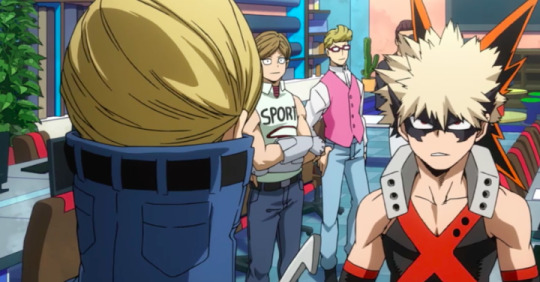
Bakugou with Best Jeanist! OMG the comedy gold of this. Though I just want to take a sec to gripe about a change from the manga to the anime: Manga! Bakugou does not charge at Best Jeanist and yell at him. He’s not dumb enough to try that on the #4 Pro Hero and his teacher. He sits still and listens to Jeanist’s lecture. The only Bakugo line here that’s from the manga is “Didn’t you make an offer for me?” This completely changes the way we perceive Bakugo in this scene, and in general. Bad change.
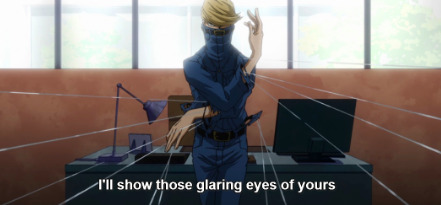
But in Good Storytelling-ville, I like the continuing parallels between the Wonder duo this creates: Izuku interns in a rundown neighborhood with an unlisted hero, Bakugo in Tokyo with a top pro. Izuku needs to learn to control his power and believe in himself. Katsuki needs to learn to be kinder and more humble. Izuku learns his lesson her, Katsuki doesn’t. Parallels!
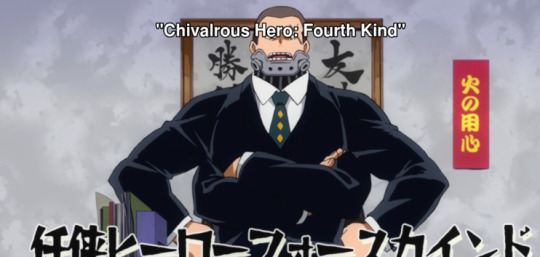
Kirishima and Tetsutetsu again! 4th kind is ok. He’s probably the least memorable of the internship pros, since his gimmick is simple and his design kinda dull.

Uraraka and Gunhead! I love how well they get along. He’s kawaii and she’s a hardcore badass. Don’t you forget it!

Now for more of Momo’s arc. The Uwabami internship is usually dismissed by fans as Just Fanservice, but think about it in context, and it becomes really interesting. One, the Hero Killer arc is about Stain protesting the commercialization of heroism, so we do need to have a Pro-Hero demonstrate the problematic nature of that commercialism. Uwabami does just that. Two, we need to have Momo’s internship be unfulfilling to her, to complete her downward trajectory (before the Final Exam arc can bring her back up), so it’s useful for further embarrassing and developing her character. 3, it sets up Momo and Kendo’s future rivalry.
I’ll take more about it in future eps where it appears.

Izuku practicing and constantly hitting his face on the wall is one of those things that makes me wonder if either a) he has a secret endurance quirk or b) OFA just naturally ups your durability. How does he still have a face after that.
Here’s a hot take: Izuku with his face smashed up from spending a night with no sleep training in garbage all night is still prettier than any other guy in this series.

One of the reviewers I follow made the comparison between All Might vs Deku’s using of OFA and Korra vs Aang’s role as the Avatar. You know, All Might and Korra, both master the power pretty quickly so they get to be strong fast but lose out on the spiritual connection a bit, while Deku and Aang take their time learning ofa/the four elements, but get as a tradeoff more of the spirit-y side...(ATLA & BNHA. My 2 favorite shows, alongside FMA. I swear these are like, three sides of the same show).

While I’m watching in the Sub this time around, i wanted to note a dub-ism in this scene: it’s localized to ‘hot pastries’ instead of taiyaki. There’s a lot of bits like that, where they take Japanese food and translate it for us dumb Americans. But well, maybe that made sense in the 90s, when there maybe wasn’t as much cultural crossover, but...even I knew what mochi were before watching BNHA (Uraraka’s fave, and the dub always localizes it to ‘sweets’) and everyone has google if they’re confused so why not just say ‘Taiyaki?’ Ah well, it’s a stupid nitpick but still.

Gran’s metaphor here is so great. As a teacher I aspire to learn from this man. Teach me your teaching ways.

“THIS TAIYAKI IS ME!!!!!” Another dub-ism has him say “I’m not really a dessert” I saw a reactor once comment on this ‘Yeah, but you are a snacc, Deku.’ I wholeheartedly agree.

FULL COWLLLLLLL!!!!!!! FYEAH!!!!!
OK so there are a lot of reasons I love Full Cowl. it’s one of the series’ finest moments, emblematic of what makes it cool. And what makes Deku cool. He’s smart, and has to work his way around problems, and this solution was just...it was there, for us and Izuku the whole time, to finally sit up and take notice of. It’s about applying power in a different way. About taking what you can do and doing the best you can with what you’ve got. A big central theme for the series.
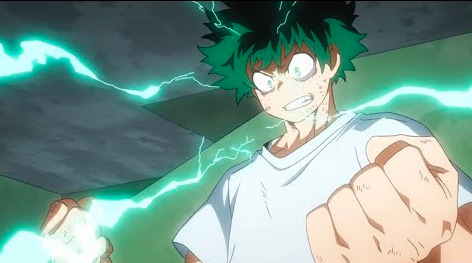
Also dayum that slow pan up Deku’s entire body as he activates it...he just looks good in this arc. Actually, post-cavalry battle Deku in the sports festival arc always looks weird and odd (because he’s beat up and in pain, duh) and prior to that he was mainly just adorable...this arc, however, is his official transition into Best Boy for Reals. He’s just...swoony. and also really cool, smart, and all sorts of great fangirl-y things.
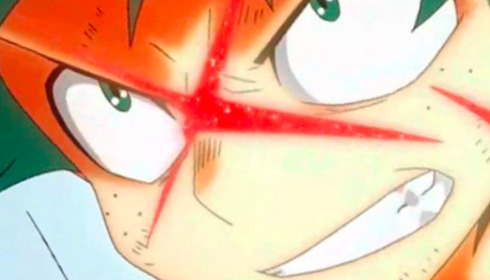
We end on a confident Deku smile and Daiki’s adorable ‘hai.’ Basically, i really enjoy this episode. A little slow at the beginning, maybe. But that conclusion is amazing and so worth the payoff. It’s even got this amazing rhyme and rhythm to it, cutting back and forth between the different students and teachers and just having themes echo between each other like poetry. It love it.

To close off: ED4, AKA BEST ED EVER!!!! This is seriously, no sarcasm, best ED. So for those of you who don’t know, the story behind ED4 Datte Atashi no Hero is, 1: The Fantasy AU theme comes from the second popularity poll, which came out around Chapter 120/Episode 61 (yes, THAT one) and for which Horikoshi drew the top 10 in fantasy garb. 2: The Song was written by LiSa and was explicitly stated by her to be effectively about Izuku’s feelings towards Kacchan. I wrote a post analyzing it. It is, basically, the anthem for...
BKDK CORNER

“Loose…” Guess who the first person Deku thinks of to create Full Cowling is? If you sad Kacchan, ding-ding-ding!
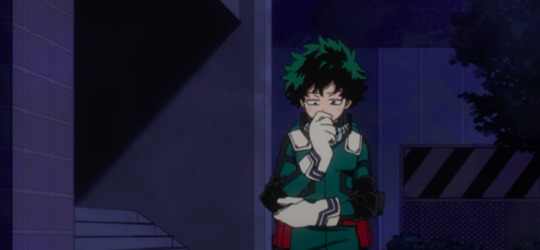

On an analytical note, I think it’s very, very significant that the first real breakthrough Deku makes in handling his power comes by observing Kacchan and imitating him. This is one of my Top 20 Favorite BKDK moments, even though it’s completely indirect, because of how important that is in the long-run. But what about the Imitation theme? Why is it OK for Izuku to imitate Katsuki, but not All Might? Well, first of all, he does use Gran Torino’s moves as well, but mainly, I think the series is saying with this distinction that it’s OK to imitate someone if you see their flaws and acknowledge them, but if you hero-worship them and see them as perfect, you’re only going to screw yourself over. This is why Iida imitating Ingenium, Shoto imitating his mom, Deku and Kacchan imitating All Might, and yes, Uraraka imitating Deku, are all so bad for them. If you see someone as perfect, and want to imitate them, you’ll never achieve that in your mind, because you already view yourself as imperfect. So Deku can imitate Katsuki because he thinks he’s a jerk, but also an amazing fighter, and Gran because he thinks he’s weird, but tough.
Also Deku just automatically thinking of Kacchan first is so damn shippy.
BEST GIRL OF THE EPISODE: Uwabami!
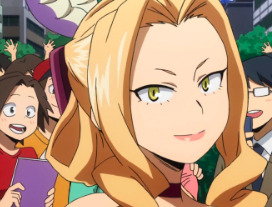
RANKER: Ranking the Internship Pros, least helpful to most.
10. Uwabami
9. Mt. Lady
8. 4th Kind
7. Endeavor
6. Death Arms
5. Manual
4. Selkie and Sirius (anime only)
3. Gunhead
2. Best Jeanist
1. Gran Torino! (Deku lucked out)
#my hero academia#episode 27#season 2 episode 14#bizarre gran torino appears#midoriya izuku#gran torino#katsuki bakugou#momo yaoyorozu#katsudeku#bakudeku#be prepared for lots of gushing#my deku bias is strong with this one#everyone has their fave#i'm glad mine's the mc#sometimes anyway#come s5 he's gonna be like#barely around for a whole damn season#anyway so glad to be at the Hero Killer arc#let's go!
16 notes
·
View notes
Text
Review: The Hating Game by Sally Thorne
So, I’m on my third of fourth reread, and it’s held up well over time. I was in a pretty shitty mood today, so it’s had its work cut out for it, battling all my negativity, which tends to manifest in intense distrust of this sort of book. I’m thinking the cynical mood will help to balance out the blinding heart eyes and give an objective perspective.
When I first read this book I thought I’d found the holy grail, and though there have been a few books after that that have taken the cake, I still think it’s wonderfully written and it has basically none of my usual rom-com pet-peeves, which makes it easy to like.
That being said, this book doesn’t try hard enough. I know this isn’t literature. I don’t expect to be tossed about so much as by Jane Eyre wandering the moors, putting her faith in nothing but God Himself; but the sheen has worn off rather quickly for a book that once held pride of place in my heart. I mean, Red, White, and Royal Blue is a rom-com through and through, but I can hardly read the emails for how heart-wrenching and raw they are, so it’s not the genre’s fault.
My main problem, which wasn’t immediately clear to me after I’d read it again, is that there’s not much of a plot or any kind of conflict at all. It’s pretty up-hill the whole ride, and even though they are “mean” to each other for a lot of the book (I’d classify this enemies-to-lovers), there is no real threat of any meaningful harm being done to there relationship, however caustic it may seem on the surface. You know they’re just flirting, albeit kinda antagonistic flirting. Of course you root for them, but at some point banter isn’t enough. As I’ve said, there’s basically no plot, and though I’m a decided rom-com light-skirt, when, for all intents and purposes, the whole book is the hooey gooey precious cuddles, the soft stares, the love words, or the antagonistic sexual tension, then the quality of the romance takes a hit. From what I can tell, the “climax” was Lucy finding out that Josh and Mindy were together a long time ago, and she feels insecure. That is quickly gotten over, though, and a hot sex scene is queued up ready to go. No big deal. Well, if the author doesn’t want too much conflict stemming directly from the romantic pair themselves, fine, but they’ve got to make up for it with conflict elsewhere, or else what am I here for? You can’t keep me on the hook if you just keep feeding me sweets. Now that the novelty has worn off, I had to shoulder all the work, trying to imbue myself with some sense that there are stakes involved and some reason to get attached to the story when there wasn’t really a whole lot to keep me invested besides her feminine wiles and his cutting whit. You gotta make me suffer a bit. You can’t rely on the characters alone to carry the romance. It always helps to develop a romantic pairing when they are forced to play with the world the author has created (e.g. The Soldier’s Scoundrel, and The Lawrence Brown Affair, both by my lady love, Cat Sebastian, to whom I’ve sold my immortal soul.) and that’s what I found most lacking
This is all thrown into unflattering relief by the holy undeserved overabundance of sap. Now that I’m looking at it with more objective familiarity (not a good mindset if you’re wanting to actually enjoy a romantic comedy) Josh’s ministrations at the end of the book especially felt over the top. Don’t get me wrong, I still go a little starry-eyed. Sally does a superb job at love talk, making it original to boot, and I was emotionally masturbating to this emotion porno of epic proportions. But if you’re going to serve me that good, you’d better make your characters suffer to balance the scale. I’m more likely to let myself enjoy that kind of over the top confessional stuff if it’s in some historical romance a la Lisa Kleypas, where I’ve already thrown out my dignity with the bathwater. But this is a real life rom-com (…oxymoron…) where the romance takes place in world whose inhabitants should be self aware enough to call bullshit. I mean, come on. There is literally a sepia-filter road trip montage scene. It’s jarring when you’re trying to enjoy something good (despite my critiques), but you’ve put it in this gaudy picture frame and you can’t help questioning it’s value. Couldn’t you have at least tried to make it seem a little more down to earth, so the negligible chance of this ever happening in the real world aren’t rubbed in my face with quite so much heartless glee? You could have made it just as poignant and also made it feel realistic. Would have pack more of a punch that way.
Anyway, one huge point in her favor: Sally does a fine job of making Josh masculine without resorting to alpha male-ism, which I suppose many authors find difficult (Looking at you, Kleypas). Lucy is cute and actually has a personality, but it irritated my that she objectified Josh as much as she did. It’s something I noticed in 99 Percent Mine, Sally’s second book, in which the objectification of the male love interest made me feel a bit ill. It started out so promising and then the romantic pair were together for a few pages and I had to stop. I’m all for the main characters taking pleasure in each other’s bodies, but the way Lucy was practically drooling over him when it came time for that, turned me off. It sounded as though she wasn’t really paying Josh himself any attention, and there was a literal scene in which she's squeezing and weighing is muscles in her hand. Gross. I’m hyper sensitive to this particular quirk in romance, and I think Sally does a good job overall of cancelling those blips out with comments on the other end of the spectrum, but it still rankles.I will say that it’s not nearly as pronounced as in 99 Percent mine.
I know this review is negative on the whole, but keep in mind, I’ve read this book four or five times, so it must being doing something right. It’s one of the better rom-coms by a long shot, and I’m sure I’ll read it again in another few months and eat it up shamelessly. Just didn’t have much patience today.
#book review#review#romance#romantic comedy#ship#book blog#book#booklr#the hating game#sally thorne#99 percent mine#book nerd
1 note
·
View note
Text
An ‘Ism’ Overview - Perspectives Comparing And contrasting art movements: The Top Game Changers in Art
There are many influential visual artists throughout history, but a few stand out for their impact on art movements and cultural zeitgeist. One of the most significant is Leonardo da Vinci, who lived from 1452 to 1519 and was a key figure in the Italian Renaissance. His iconic artwork, the Mona Lisa, has become one of the most recognized and studied paintings in the world, and his technical innovations and scientific curiosity continue to influence artists and thinkers today. Another notable figure is Pablo Picasso, who lived from 1881 to 1973 and is credited with co-founding the Cubist movement. His groundbreaking work Les Demoiselles d'Avignon challenged traditional notions of perspective and representation, paving the way for abstract and conceptual art. Finally, Andy Warhol, who lived from 1928 to 1987, was a leading figure in the Pop Art movement and famous for his screen-printed images of everyday objects like Campbell's soup cans and Marilyn Monroe. His work blurred the boundaries between high and low culture, challenging viewers to reconsider their relationship to consumerism and celebrity. These artists and many others like them have left an indelible mark on the history of art and continue to inspire new generations of creators.
2 notes
·
View notes
Photo

Thinking Horror: A Journal of Horror Philosophy; Volume Two: The Horror Boom, edited by S.J. Bagley, TKHR, October 2015. Cover Art by Stephen Wilson, info: thinkinghorror.net.
The second volume of Thinking Horror: A Journal of Horror Philosophy focuses loosely on the horror boom of the second half of the Twentieth Century.
Contents: THNKHRRR Editorial: S.J. Bagley THNKHRRR Interview: Steve Rasnic Tem “The Word in Flesh, or Whenever We’re Opened, We’re Red: A Personal Meditation on Clive Barker’s Books of Blood” by Gemma Files “An Endless Laceration: The Limit Experience in Horror” by Daniel Pietersen “The Impossible Literature of Thomas Ligotti, Puppeteer and Eschatologist” by D. P. Watt THNKHRRR Interview: Lisa Tuttle “‘Your Worst Fear’: Monstrous Feminine(ism) and the Horror Boom of the 1970s” by Andrew P. Williams “The Grotesque in Flannery O’Connor’s ‘A Good Man is Hard to Find’ and ‘Good Country People'” by Kristi DeMeester THNKHRRR Interview: John Skipp “A Faint Sense of Double Vision”: Cinematic Tensions and Transmedial Anxieties in the Fiction of Files/Barringer, Wehunt, Tremblay, Link, and Ballingrud” by Christopher Burke THNKHRRR Interview: Nick Mamatas “His Knife, Her Shadow” by John Glover “Nothing Will Have Happened: Speculation and Horror in the Anthropocene” by David Peak THNKHRRR Interview: Paul Tremblay “Collective Abjection: Social Horror in Stephen King’s It” by Mike Thorn “‘Hello from the Sewers of NYC’: T.E.D. Klein’s ‘Children of the Kingdom'” by Michael Cisco
#magazine#literary journal#journal#weird essay#horror essay#weird studies#horror studies#studies in supernatural fiction#horror philosophy
13 notes
·
View notes
Text
Comparing concept art



The first piece of work is by Jean-Honore Frangonard, a french artist from the 1800′s who favored a Rococo art style. His work often depicts luxury of life and demonstrates his impression of hedonism. This suggestive piece of work by him is titled The Swing and although at the time, it could have been slightly inappropriate, today it is merely expression - and was sensible enough for a family company such as Walt Disney Studios to stem their concept art for the 2009 animation Tangled from Frangard’s unconventional-ism.
Below The Swing by Frangard is a painting from Lisa Keane, the partner of Glen Keane, both legendary figures in the Disney production world. The concept art went to contribute to the final depiction of Rapunzel in the clip taken from Rapunzel’s exit of her tower shown in the last image.
Similarities:
The angle of the swing is near identical in all three pieces of work
All versions include a rumpled and lined flowing skirt of similar length and in a romantic style fashion
Though the first features a strawberry blonde, all depictions are blonde, expression of joy on their rosy cheeks
Differences:
Where there is a tree in the first two concepts, the clip from Tangled features the brick of her tower in a similar rough and natural texture as well as earthy tones.
Pink dresses in the first two concepts turn to purple in the film
There is not as much nature, however, this isn’t the only depiction/reference to their concept art in the entirety of the film Tangled

In a separate clip of the film shown above, Rapunzel swings from a tree with a different method but swing nonetheless. Here, we can see the abundance in nature that is a direct conveying of the concept art by Lisa Keane and the original inspiration by Jean-Honore Frangonard.
Disney modernised both concepts and added the characters personality to make it historically relevant in regards to the narrative of the art that inspired it (the relation to Frangonard’s work hasn’t been lost visually) as well as making it accurate to the characters attitude, time period, environment and the genre/audience of the movie.
Note: though there are many differences in the concept art, I have mentioned the most essential that I feel change the perception or depiction of the character instead of simple artistic choice or favorability.
e.g. The gargoyle in Frangonards painting is absent in Lisa Keane’s concept art. I believe the gargoyle to be ineffective in the storytelling they were focusing on during the creation of Tangled, as well as it being unnecessary it would eventually be random in the middle of a forest where Rapunzel lived and would subsequently change the entire design of the forest/atmosphere of the film.
Their inspiration sprung from Frangonard’s work, but did not attempt to replicate to an identical extreme.
1 note
·
View note
Link
this article is dumb, i shouldn’t be hate-reading and you shouldn’t either but here we are so let’s do this:
We begin with a description of a platformer doing something clever and metatextual at the end. Followed by;
What this means is that the game stands in stark contrast to an industry whose products, historically speaking, rely on hijacking the reptile brains of hormone-crazed teenaged boys. In short, the history of videogames is the history of the glorification of violence.
Ah yes, who can forget such bloodthirsty products of the military-industrial complex as Pong, Tetris, Pacman or Zork?
We can debate what constitutes the first videogame, and whether it’s fair to attribute the invention of videogames to the military,
Given the contentiousness of that assertion, I should certainly hope so!
but what’s undeniable is that military engineers—ever ready to coopt, conspire with, or commission innovation from the private sector (e.g., the splitting of the atom, the invention of I.Q.)—more or less immediately recognized that videogames could be employed as a cheap substitute for teaching soldiers how to do everything from fly a plane to take out a sniper.
Kinda reductive to reduce the history of video games to FPSes in general and America’s Army in particular, doncha think?
Anyway, then we get some more waffle about how first-person shooters video games are training us to kill, before we get to the real question: given that this platformer he just finished playing did something a little artsy, can video games be art even despite the fact that were originally works of military propaganda intended to inure potential military recruits to violence? And more importantly, given that this guy seems to think the history of video games began with first person shooters, is he really qualified to answer this question?
Then we get some pointless side chatter over the claim that games are good for your brain, followed by the charge that games are addictive--despite the explicit comparison made to gambling (at “your local Native American casino,” no less), there is no discussion of lootboxes or microtransactions whatsoever, suggesting the author is not aware of specific steps which are taken to make games addictive and is just invoking vague notions of all games being addictive. None of this ever comes up again, and we promptly move back to talking about the actual game.
More specifically, Inside is what’s known as a “2D side-scroller”—meaning that you observe your figure mostly in profile in the center of your screen while a background landscape scrolling right-to-left gives the illusion of left-to-right forward motion.
Somehow, the use of the term “2D side-scroller” in quotes does not make me feel that this fellow is sufficiently familiar with video games to assess whether or not they can be art, as does the fact that he reckons that the platformer he is playing hearkens back to a 1981 shoot-em-up he remembers from his teens, which makes his apparent conviction that video games originated as first person shooters all the more baffling.
And while the world of videogames has already become a “spectator sport,” I’m unaware of any instance of the record of a videogame player’s performance becoming intellectual property, as it has in the world of chess, and in a whole array of sports. True, gamers go “professional” by attracting followers on the internet and earning ad revenue, but their play itself is not copyrighted. Games might wind up in museums (worldwide, there are at least seventeen museums dedicated to videogames), but bracketed moments of the play of particular games have not yet become value-able as art.
I invite the author to start selling unauthorized DVDs of clips from popular Twitch streamers and gaming YouTubers and see how long their lawyers allow him to entertain the notion that Let’s Plays do not constitute intellectual property.
the 2D side-scroller and its pitbull of a cousin, the first-person shooter,
???
The rest of the section is pretty unremarkable, so we move onto him complaining about lousy movie critique, then lousy video game critique, then explaining the concept of Easter eggs, then video game puzzles:
The puzzles of Limbo and Inside are more ambitious than the puzzles of most games in that their solutions often require the player to wait, or to exhibit what in psychology and education circles is known as divergent thought—for example, a corpse is a corpse, but it is also potentially a deadweight that can be used to spring a boobytrap.
Making the player wait or use an unusual object as a weight doesn’t strike me as particularly devilishly clever.
Then we get this jewel of a paragraph:
Nevertheless, puzzles themselves stand as an obstacle blocking the path of videogames’ journey from game to art. For while I might willingly suspend my disbelief long enough to accept that a boy has been tasked with jogging exhaustedly through a factory that churns out invincible blob creatures, I will find that willingness strained when I am also confronted with confounding puzzles placed in my path for no good reason. Videogames, in other words, ignore the basic tenets of internal consistency—in order to keep playing, you must suspend your disbelief, and then suspend it again, and again, and again, which means that in order to play and enjoy videogames you must also suspend the kind of critical judgment that is normally associated with art.
You heard it here, folks, accepting weird gameplay conceits means you can’t critically analyze a game.
Similarly, Easter eggs appeal only on the level of geek fetish—which is more or less the opposite of critical appreciation—and it is for this reason that I won’t address the puzzles and Easter eggs in Inside, even though they eventually lead to what some have concluded is the game’s “hidden meaning.” And this is the problem of videogames in a nutshell, because meaning in work of art is no more hidden from its beholder than the summit of a mountain is hidden from the mountain climber.
Sounds to me more like the problem is that he’s ignoring what the game itself is telling him about its plot and themes because it’s doing it in a way he finds aesthetically displeasing. I don’t know much about critical analysis but I feel like that’s not really how you should be doing it.
We then get a description of the plots of Limbo and Inside, including a decent bit of analysis marred by a bit of “murder simulator”-ism.
This is worth noting because prior to this moment the violence the boy has inflicted, either in Limbo or Inside, has been indirect—really an act of self-defense—but now the game is threatening to creep back into the usual videogame mode of affectless murder. You are given a choice: slip backward toward the wantonly horrific likes of Grand Theft Auto (1997) and Postal 2 (2003) [3] , or pause a moment and then continue on in a macabre but not morally bankrupt pursuit narrative. In this way, the player is implicated in a wryly disjointed bit of commentary on the history of gaming itself.
I mean this entirely sincerely: someone should get this guy a copy of Undertale. I think he’d enjoy it, if he could get past the idea of having to accept JRPG conventions.
Sadly, video game still aren’t art because he can list a bunch of movies that had vaguely similar elements:
From there, it’s not hard to find antecedents for Inside in both literature and film—it’s a little bit Soylent Green, a little bit Logan’s Run, a little bit The Island of Dr. Moreau, and more than a little bit Frankenstein. The imagery starts to seem familiar, too, with milieus lifted from E.T., Alien, and The Poseidon Adventure. But all this allusive flotsam becomes a bit of a disappointment, as eventually you become hard pressed to find anything in Inside that you haven’t seen inside something else.
Ezra Pound demanded that artists “make it new,” and Marcel Proust insisted that a writer is someone who invents a voice as unique as his or her fingerprint, but Inside isn’t even really trying to tell a story that hasn’t been told before. That’s a problem. Art cannot be made up wholly of references to other art. Star Wars, for example, does not come close to art because at its core it is nothing more than a pre-fab mash-up of archetypes mail-ordered from the IKEA superstore of Joseph Campbell.
I mean... why can’t art be composed solely of references to other art? Why can the whole not be more than the sum of its parts? If I take a picture of the Mona Lisa and photoshop a photo of a can of soup over her head, the resulting work is distinct from either of the originals, even though I provided no original content except the idea of sticking the two together.
Put another way, Inside could only have been designed by someone who hasn’t read Roland Barthes’s “The Death of the Author,” and hasn’t read Walter Benjamin’s “The Work of Art in the Age of Mechanical Reproduction,” and hasn’t read T.S. Eliot’s “Tradition and the Individual Talent”—someone who hasn’t, in other words, engaged theoretically with what art is. And that, in turn, leads to the simple conclusion that on the level of its plot Inside is not trying to do what art does.
Good god this guy is snobbish.
Second, there’s still the meta-twist to consider: perhaps Inside is a game with both a text and a subtext. And perhaps a subtext can help the videogame industry evolve beyond the hyperviolence that is its womb and its crutch.
“Hyperviolent” is not exactly how I would describe Breakout or Super Mario Bros. Anyway, he then ponders the potential meaning of the evil scientists at the end of the game being stand-ins for the developers, and comes to the conclusion that...
The problem of games today is that their creators have not imagined any purpose for them greater than fun. There are exceptions to this, of course, but for the most part games equate escape with distraction—to be distracted is to be entertained, and it is good to be entertained.
Unlike the rest of popular media, of course.
The obligation of art, as Henry James described it, is to be interesting, and if you’re paying attention, that is to say, if you’re trying for more than distraction, then Inside begins to be interesting with its name, which stands in stark contrast to games like Call of Duty: Infinite Warfare and Grand Theft Auto: Vice City.
I too enjoy criticizing games for being superficial based on their titles.
Then we get some final analysis, a quote from a Raymond Carver short story I read in high school and remember mostly as something my friends in English class found homoerotic subtext in, and the claim that the goal of art is a feeling of transcendental bliss:
The much remarked-upon narrator of Raymond Carver’s classic short story, “Cathedral,” experiences such a moment as the story climaxes with a blind man helping him draw a church. “My eyes were still closed,” the narrator says. “I was in my house. I knew that. But I didn’t feel like I was inside anything.”
At its most ambitious, Inside aspires to a similar feeling. Escape in art that is not transcendence is cheap, and if you can climb beyond the foolish puzzles and the Easter eggs and the hidden meanings, you can feel, for a moment, that you are not alone on your sofa with your phone, playing a game; rather, you are somewhere else—somewhere grassy, bathed in warmth by a ray of sunlight falling from above.
And that’s nice and all but it feels like he didn’t really lead up to it.
Anyway, I spent way too much time picking through this but here we go. Final rating: 2/10, the next time you want to know if video games are art yet ask someone who actually plays them.
1 note
·
View note